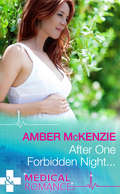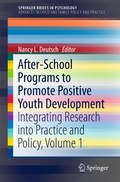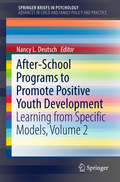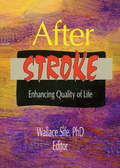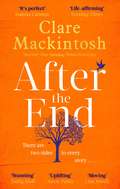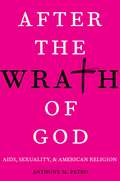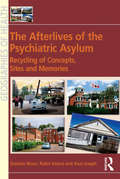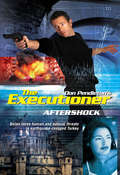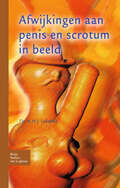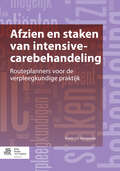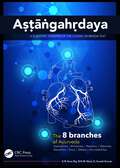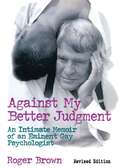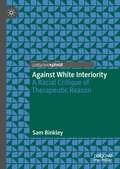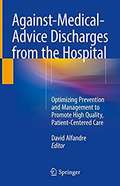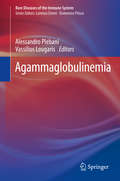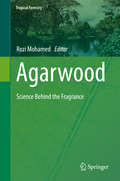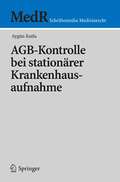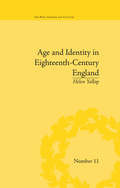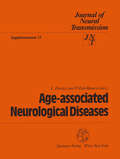- Table View
- List View
After One Forbidden Night... (Mills And Boon Medical Ser.)
by Amber McKenzieThe cost of the forbidden…Successful ER physician Dr Chloe Darcy has her professional life all sewn up. Her love life is another matter! Being secretly in love with powerful, charismatic vascular surgeon Tate Reed is torture… As her best friend’s ex, he’s strictly off-limits!
After-School Programs to Promote Positive Youth Development: Integrating Research into Practice and Policy, Volume 1 (SpringerBriefs in Psychology)
by Nancy L. DeutschThe first volume of this SpringerBrief presents a series of papers compiled from a conference about how after-school programs may be implemented to promote positive youth development (PYD) hosted by Youth-Nex, the University of Virginia Center to Promote Effective Youth Development. This volume reviews the importance of after-school programs for PYD and discusses key components of effective after-school programs. It also discusses issues related to the evaluation and measurement of quality in after-school programs. In addition, the brief presents suggestions for how researchers, policy makers, and practitioners can move the field forward and maximize the potential of after-school time and programs for promoting positive youth development for children and adolescents. Topics featured in this brief include: The history of the relationship between after-school programs and positive youth development. Specific features of programs that are important for advancing positive youth development. Issues in and approaches to measuring quality in after-school programs.The Quality, Engagement, Skills, Transfer (QuEST) model and its use for measuring effective after-school programs. A case study evaluation of the Girls on the Run program. After-School Programs to Promote Positive Youth Development, Volume 1, is a must-have resource for policy makers and related professionals, graduate students, and researchers in child and school psychology, family studies, public health, social work, law/criminal justice, and sociology.
After-School Programs to Promote Positive Youth Development: Learning from Specific Models, Volume 2 (SpringerBriefs in Psychology)
by Nancy L. DeutschThe second volume of this SpringerBrief presents a series of papers compiled from a conference addressing how after-school programs can promote positive youth development (PYD) hosted by Youth-Nex, the University of Virginia Center to Promote Effective Youth Development. It examines summer learning and best practices for different types of after-school programs by drawing on the experiences of researchers, program staff, and youth participants. It also presents case studies of five specialized programs and discusses their strengths, limitations, and challenges. In addition, the brief offers recommendations drawn from across the two volumes for how researchers, policy makers, and practitioners can move the field forward and maximize the potential of after-school time and programs to promote positive youth development for children and adolescents. Featured case studies of specialized after-school programs include: Richmond, Virginia’s ROSMY.The Clubhouse: Where Technology Meets Imagination.The Young Women Leaders Program (YWLP).Whatever It Takes (WIT) Program.UTEC of Lowell, Massachusetts.After-School Programs to Promote Positive Youth Development, Volume 2, is a must-have resource for policy makers and related professionals, graduate students, and researchers in child and school psychology, family studies, public health, social work, law/criminal justice, and sociology.
After Stroke: Enhancing Quality of Life
by Wallace SifeAfter Stroke: Enhancing Quality of Life brings together an extraordinary selection of advice, practical survivor techniques, information about resources, and personal stories of triumph. It is designed to help those who have experienced a stroke attain the highest quality of life possible, under their new physical restrictions.Recuperating from a stroke is an arduous process that has only just begun when the survivor is released from the hospital. This book shows anyone interested how to create an effective climate for healing and how to help the survivor realize his/her fullest recovery potential. It offers varied perspectives of everyone involved with a stroke: the patient, the family, and friends as well as the team of specialized physicians, nurses, psychologists, physical therapists, speech pathologists, and diverse therapists.Through its interesting and varied essays, After Stroke: Enhancing the Quality of Life offers the reader a clearer understanding of the injuries that the body as well as the mind have sustained. This anthology is carefully designed to present enhanced perspectives into all aspects of the healing and recovery processes that follow the personal tragedy of a stroke.
After Stroke: Enhancing Quality of Life
by Wallace SifeAfter Stroke: Enhancing Quality of Life brings together an extraordinary selection of advice, practical survivor techniques, information about resources, and personal stories of triumph. It is designed to help those who have experienced a stroke attain the highest quality of life possible, under their new physical restrictions.Recuperating from a stroke is an arduous process that has only just begun when the survivor is released from the hospital. This book shows anyone interested how to create an effective climate for healing and how to help the survivor realize his/her fullest recovery potential. It offers varied perspectives of everyone involved with a stroke: the patient, the family, and friends as well as the team of specialized physicians, nurses, psychologists, physical therapists, speech pathologists, and diverse therapists.Through its interesting and varied essays, After Stroke: Enhancing the Quality of Life offers the reader a clearer understanding of the injuries that the body as well as the mind have sustained. This anthology is carefully designed to present enhanced perspectives into all aspects of the healing and recovery processes that follow the personal tragedy of a stroke.
After the End: The most moving book you'll read in 2019
by Clare MackintoshThe powerful and page-turning new novel from number one Sunday Times bestseller, Clare Mackintosh.'The most moving book you'll read this year' LISA JEWELL'Compelling and clever, tender and true. I can't stop thinking about it' LIANE MORIARTYMax and Pip are the strongest couple you know. Only now they're facing the most important decision of their lives - and they don't agree.As the consequences of an impossible choice threaten to devastate them both, nothing will ever be the same again.But anything can happen after the end . . . .____________________Everyone is talking about After the End:'This was a heart-breaking read and at times I forgot to breathe' 'If I could give this book 10 stars I would' 'This book touched my soul' 'I could not put it down. What a story. What a storyteller' 'This is in my top five books of all time. Absolutely incredible' 'I have never felt so emotionally wrapped up in characters in a book'
After the Wrath of God: AIDS, Sexuality, & American Religion
by Anthony M. PetroOn a cold February morning in 1987, amidst freezing rain and driving winds, a group of protesters stood outside of the Unitarian Universalist Church in Amherst, Massachusetts. The target of their protest was the minister inside, who was handing out condoms to his congregation while delivering a sermon about AIDS, dramatizing the need for the church to confront the seemingly ever-expanding crisis. The minister's words and actions were met with a standing ovation from the overflowing audience, but he could not linger to enjoy their applause. Having received threats in advance of the service, he dashed out of the sanctuary immediately upon finishing his sermon. Such was the climate for religious AIDS activism in the 1980s. In After the Wrath of God, Anthony Petro vividly narrates the religious history of AIDS in America. Delving into the culture wars over sex, morality, and the future of the American nation, he demonstrates how religious leaders and AIDS activists have shaped debates over sexual morality and public health from the 1980s to the present day. While most attention to religion and AIDS foregrounds the role of the Religious Right, Petro takes a much broader view, encompassing the range of mainline Protestant, evangelical, and Catholic groups--alongside AIDS activist organizations--that shaped public discussions of AIDS prevention and care in the U.S. Petro analyzes how the AIDS crisis prompted American Christians across denominations and political persuasions to speak publicly about sexuality--especially homosexuality--and to foster a moral discourse on sex that spoke not only to personal concerns but to anxieties about the health of the nation. He reveals how the epidemic increased efforts to advance a moral agenda regarding the health benefits of abstinence and monogamy, a legacy glimpsed as much in the traction gained by abstinence education campaigns as in the more recent cultural purchase of gay marriage. The first book to detail the history of religion and the AIDS epidemic in the U.S., After the Wrath of God is essential reading for anyone concerned with the intersection of religion and public health.
After the Wrath of God: AIDS, Sexuality, & American Religion
by Anthony M. PetroOn a cold February morning in 1987, amidst freezing rain and driving winds, a group of protesters stood outside of the Unitarian Universalist Church in Amherst, Massachusetts. The target of their protest was the minister inside, who was handing out condoms to his congregation while delivering a sermon about AIDS, dramatizing the need for the church to confront the seemingly ever-expanding crisis. The minister's words and actions were met with a standing ovation from the overflowing audience, but he could not linger to enjoy their applause. Having received threats in advance of the service, he dashed out of the sanctuary immediately upon finishing his sermon. Such was the climate for religious AIDS activism in the 1980s. In After the Wrath of God, Anthony Petro vividly narrates the religious history of AIDS in America. Delving into the culture wars over sex, morality, and the future of the American nation, he demonstrates how religious leaders and AIDS activists have shaped debates over sexual morality and public health from the 1980s to the present day. While most attention to religion and AIDS foregrounds the role of the Religious Right, Petro takes a much broader view, encompassing the range of mainline Protestant, evangelical, and Catholic groups--alongside AIDS activist organizations--that shaped public discussions of AIDS prevention and care in the U.S. Petro analyzes how the AIDS crisis prompted American Christians across denominations and political persuasions to speak publicly about sexuality--especially homosexuality--and to foster a moral discourse on sex that spoke not only to personal concerns but to anxieties about the health of the nation. He reveals how the epidemic increased efforts to advance a moral agenda regarding the health benefits of abstinence and monogamy, a legacy glimpsed as much in the traction gained by abstinence education campaigns as in the more recent cultural purchase of gay marriage. The first book to detail the history of religion and the AIDS epidemic in the U.S., After the Wrath of God is essential reading for anyone concerned with the intersection of religion and public health.
The Afterlives of the Psychiatric Asylum: Recycling Concepts, Sites and Memories (Geographies of Health Series)
by Graham Moon Robin KearnsThe last 40 years has seen a significant shift from state commitment to asylum-based mental health care to a mixed economy of care in a variety of locations. In the wake of this deinstitutionalisation, attention to date has focussed on users and providers of care. The consequences for the idea and fabric of the psychiatric asylum have remained 'stones unturned'. This book address an enduring yet under-examined question: what has become of the asylum? Focussing on the 'recycling' of both the idea of the psychiatric asylum and its sites, buildings and landscapes, this book makes theoretical connections to current trends in mental health care and to ideas in cultural/urban geography. The process of closing asylums and how asylums have survived in specific contexts and markets is assessed and consideration given to the enduring attraction of asylum and its repackaging as well as to retained mental health uses on former asylum sites, new uses on former sites, and interpretations of the derelict psychiatric asylum. The key questions examined are the challenges posed in seeking new uses for former asylums, the extent to which re-use can transcend stigma yet sustain memory and how location is critical in shaping the future of asylum and asylum sites.
The Afterlives of the Psychiatric Asylum: Recycling Concepts, Sites and Memories (Geographies of Health Series)
by Graham Moon Robin KearnsThe last 40 years has seen a significant shift from state commitment to asylum-based mental health care to a mixed economy of care in a variety of locations. In the wake of this deinstitutionalisation, attention to date has focussed on users and providers of care. The consequences for the idea and fabric of the psychiatric asylum have remained 'stones unturned'. This book address an enduring yet under-examined question: what has become of the asylum? Focussing on the 'recycling' of both the idea of the psychiatric asylum and its sites, buildings and landscapes, this book makes theoretical connections to current trends in mental health care and to ideas in cultural/urban geography. The process of closing asylums and how asylums have survived in specific contexts and markets is assessed and consideration given to the enduring attraction of asylum and its repackaging as well as to retained mental health uses on former asylum sites, new uses on former sites, and interpretations of the derelict psychiatric asylum. The key questions examined are the challenges posed in seeking new uses for former asylums, the extent to which re-use can transcend stigma yet sustain memory and how location is critical in shaping the future of asylum and asylum sites.
Aftershock
by Don PendletonSHOCK WAVE Mack Bolan is in Turkey to recover millions in stolen medical and relief supplies earmarked for displaced refugees in the civil-war-torn region. Racing to reclaim the cache before a violent insurgent group sells everything on the black market, Bolan finds his mission compromised when a massive earthquake rocks the region.
Afwijkingen aan penis en scrotum in beeld
by H. H. LeliefeldMet Afwijkingen aan penis en scrotum in beeld is er eindelijk een boek dat in beeld en tekst een moeilijk bespreekbaar onderwerp toegankelijk maakt. Immers, om urologische penoscrotale afwijkingen hangt nog steeds een onnodige en ongewenste taboesfeer die bovendien wordt versterkt door de irreële wereld van glossy-tijdschriften en reclame waarin alleen perfecte mensen lijken te bestaan. De schroom zit aan twee kanten. De patiënt denkt veelal - onterecht! - dat hij de enige is met zo´n afwijking. De niet-urologisch geschoolde arts heeft vaak te weinig ervaring met de fysische diagnostiek van urologische penoscrotale afwijkingen en slaat daardoor - net zo onterecht! - het penoscrotale gebied over bij lichamelijk onderzoek. Dit boek is een aansporing om bij lichamelijk onderzoek het penoscrotale gebied niet over te slaan, want er is vaak wel iets te vinden. Geïllustreerd met 100 afbeeldingen worden hier diverse "gewone", maar ook soms bizarre afwijkingen aan penis en scrotum getoond. Iedere urologische afwijking is voorzien van informatie aangaande diagnose, oorzaak, epidemiologie en therapie. Het maakt het boek buitengewoon waardevol voor gebruik in de dagelijkse praktijk van (huis)artsen, urologen en seksuologen. Ook voor studenten geneeskunde is dit boek een onmisbare bron van informatie.
Afzien en staken van intensive-carebehandeling: Routeplanners voor de verpleegkundige praktijk
by Erwin J.O. KompanjeIntensive care staat vooral bekend om het medisch-technisch handelen bij ernstig zieke patiënten. Dit hoogtechnologische handelen leidt helaas niet altijd tot genezing van de patiënt. De sterfte op een intensive care is, vergeleken met andere afdelingen in het ziekenhuis, dan ook hoog. Van alle patiënten die op een IC komen te overlijden, sterven in Nederland acht van de tien nadat besloten is dat verder behandelen niet meer in het belang van de patiënt is en de ingezette behandeling gestaakt wordt. Omdat de meeste patiënten bij wie de behandeling gestaakt wordt ernstig orgaanfalen hebben, kan dit aanleiding geven tot belastende symptomen zoals benauwdheid, reutelen, onrust, pijn en andere vormen van discomfort.Artsen en verpleegkundigen hebben de morele taak om deze symptomen zo goed mogelijk te behandelen teneinde de patiënt zo rustig mogelijk te kunnen laten overlijden. Beter is het om te anticiperen op mogelijk belastende symptomen. Helaas zijn veel artsen en verpleegkundigen onwennig in het geven van anticiperende palliatieve zorg op de IC. In dit boekje worden praktische routeplanners gegeven die artsen en verpleegkundigen op de IC stap voor stap kunnen helpen bij de zorg voor stervende patiënten op de IC.
Aṣṭāṅgahṛdaya: A Scientific Synopsis of the Classic Ayurveda Text
by G.R. Arun Raj N.K.M. Ikbal D. Suresh KumarWorldwide interest in Ayurveda is on the rise, ever since the World Health Organization adopted the Alma Ata Declaration in 1978. Ayurveda is increasingly being adopted and many phytotherapy schools in Europe and the Americas teach Ayurveda as a wellness system. Considering the prominent position that Aṣṭāṅgahṛdaya occupies in Ayurveda, a scientific synopsis of this masterpiece is now presented before the world of Ayurveda. In eight comprehensive chapters, Aṣṭāṅgahṛdaya: A Scientific Synopsis of the Classic Ayurveda Text presents a lucid summary of the teachings of Vāgbhaṭa. Ayurvedic view of the human body, basic principles of Ayurveda, surgical armamentarium, diagnosis and treatment of diseases, herbs and other medicinal substances used in the preparation of various dosage forms, ayurvedic pharmaceutialcs, ayurvedic approach to food fortification, salient features of Aṣṭāṅgahṛdaya and a roadmap for the future are among the topics discussed. Key Features: Presents the ayurvedic view of conception and the human body. Discusses aspects of ayurvedic pharmaceuticals. Examines diagnosis of diseases, lines of treatment, prognosis of diseases, signs of imminent death, management of mishaps and treatment of new diseases. The voluminous information pertaining to the subjects of the various chapters is presented in the form of many tables for ready reference and quick survey. This book provides a helping hand to those interested in rediscovering the teachings of Vāgbhaṭa and is a great resource for researchers of medicine, traditional and alternative medicine, pharmacology and drug discovery.
Aṣṭāṅgahṛdaya: A Scientific Synopsis of the Classic Ayurveda Text
by G.R. Arun Raj N.K.M. Ikbal D. Suresh KumarWorldwide interest in Ayurveda is on the rise, ever since the World Health Organization adopted the Alma Ata Declaration in 1978. Ayurveda is increasingly being adopted and many phytotherapy schools in Europe and the Americas teach Ayurveda as a wellness system. Considering the prominent position that Aṣṭāṅgahṛdaya occupies in Ayurveda, a scientific synopsis of this masterpiece is now presented before the world of Ayurveda. In eight comprehensive chapters, Aṣṭāṅgahṛdaya: A Scientific Synopsis of the Classic Ayurveda Text presents a lucid summary of the teachings of Vāgbhaṭa. Ayurvedic view of the human body, basic principles of Ayurveda, surgical armamentarium, diagnosis and treatment of diseases, herbs and other medicinal substances used in the preparation of various dosage forms, ayurvedic pharmaceutialcs, ayurvedic approach to food fortification, salient features of Aṣṭāṅgahṛdaya and a roadmap for the future are among the topics discussed. Key Features: Presents the ayurvedic view of conception and the human body. Discusses aspects of ayurvedic pharmaceuticals. Examines diagnosis of diseases, lines of treatment, prognosis of diseases, signs of imminent death, management of mishaps and treatment of new diseases. The voluminous information pertaining to the subjects of the various chapters is presented in the form of many tables for ready reference and quick survey. This book provides a helping hand to those interested in rediscovering the teachings of Vāgbhaṭa and is a great resource for researchers of medicine, traditional and alternative medicine, pharmacology and drug discovery.
Against My Better Judgment: An Intimate Memoir of an Eminent Gay Psychologist
by Roger BrownAgainst My Better Judgment: An Intimate Memoir of an Eminent Gay Psychologist is an extraordinary and moving account of the life of a gay man in his late 60s after he loses his companion of 40 years to cancer. A leading professor of psychology at Harvard University, Roger Brown bravely comes forth with his compelling story of grief, loneliness, and a relentless search for intimacy, healing, and self-acceptance. Readers gain insight into a stage of life experienced by gay men of which little is written or spoken due to the ageism that characterizes homosexual culture. Against My Better Judgment reveals deeply personal truths that will prepare gay men for what to expect in the later stages of life. Universal in nature, these truths will speak to readers from various lifestyles and of all ages. Readers will recognize the book as a story of looking for love in all the wrong places, but will also see in it a process of discovery--both internal and external. In the aftermath of his lover&’s death, Brown turns to prostitutes for companionship, for relieving repressed sexual energy, and even for love. Through his unique relationships with three young men, he does not find the romantic love he so desperately seeks, but discovers that his idea of human nature has been formed by his particular life position and association with people who share his values, knowledge, and privileges. Once he goes outside his social and intellectual circle, he acquires a new perspective on life and realizes how far from universal truth his notions of humanity have been.Readers of Against My Better Judgment will gain a different perspective on the complexities of love, relationships, fidelity, human nature, and the hardships of life inevitably faced by all humans--straight, gay, or bisexual. Gay men, lesbians, psychologists, widowers, therapists, and anthropologists, as well as sensitive readers of any background, will heighten their understanding of what it means to be human. This remarkable story makes a tremendous contribution to existing gay literature and the timeless struggle of art and literature to make sense of the universe and the place of humans within it. Echoing life, Against My Better Judgment, with its brutal honesty, intrigues and repels alternately, just as it elicits both sadness and laughter.
Against My Better Judgment: An Intimate Memoir of an Eminent Gay Psychologist
by Roger BrownAgainst My Better Judgment: An Intimate Memoir of an Eminent Gay Psychologist is an extraordinary and moving account of the life of a gay man in his late 60s after he loses his companion of 40 years to cancer. A leading professor of psychology at Harvard University, Roger Brown bravely comes forth with his compelling story of grief, loneliness, and a relentless search for intimacy, healing, and self-acceptance. Readers gain insight into a stage of life experienced by gay men of which little is written or spoken due to the ageism that characterizes homosexual culture. Against My Better Judgment reveals deeply personal truths that will prepare gay men for what to expect in the later stages of life. Universal in nature, these truths will speak to readers from various lifestyles and of all ages. Readers will recognize the book as a story of looking for love in all the wrong places, but will also see in it a process of discovery--both internal and external. In the aftermath of his lover&’s death, Brown turns to prostitutes for companionship, for relieving repressed sexual energy, and even for love. Through his unique relationships with three young men, he does not find the romantic love he so desperately seeks, but discovers that his idea of human nature has been formed by his particular life position and association with people who share his values, knowledge, and privileges. Once he goes outside his social and intellectual circle, he acquires a new perspective on life and realizes how far from universal truth his notions of humanity have been.Readers of Against My Better Judgment will gain a different perspective on the complexities of love, relationships, fidelity, human nature, and the hardships of life inevitably faced by all humans--straight, gay, or bisexual. Gay men, lesbians, psychologists, widowers, therapists, and anthropologists, as well as sensitive readers of any background, will heighten their understanding of what it means to be human. This remarkable story makes a tremendous contribution to existing gay literature and the timeless struggle of art and literature to make sense of the universe and the place of humans within it. Echoing life, Against My Better Judgment, with its brutal honesty, intrigues and repels alternately, just as it elicits both sadness and laughter.
Against White Interiority: A Racial Critique of Therapeutic Reason
by Sam BinkleyThis book presents a bold critique of the new racial sensibility that has attained global prominence following the police murder of George Floyd. Through a set of managerial and therapeutic discourses, this new sensibility describes the inner racial life of white subjects, inducing them to adopt a therapeutic attitude toward deeply interiorized white emotions and conflicts. In so doing, the new racial sensibility promises to remake whiteness in the image of the self-aware racial ally. However, such an appeal, it is argued, serves the subtle function of the preservation of white racial dispositions, and the reproduction of the very racism it sets out to transform. Adopting a critical lens derived from Michel Foucault’s analysis of sexuality, together with an engagement with sociological, psychoanalytic and phenomenological reflections on shame as a racial affect, a critique of white interiority considers alternative frames through which white anti-racist subjection might be imagined.
Against‐Medical‐Advice Discharges from the Hospital: Optimizing Prevention and Management to Promote High Quality, Patient-Centered Care
by David AlfandreThis first-of-its-kind text provides a multidisciplinary overview of a significant problem in hospital-based healthcare: patients who decline inpatient medical care and leave the hospital against medical advice (AMA). Compared to standard hospital discharges, AMA discharges are associated with worse health and health services outcomes. Patients discharged AMA have been found to have disproportionately higher rates of substance use, psychiatric illness, and report stigmatization and reduced access to care. By providing a far reaching examination of AMA discharges for a wide academic and clinical audience, the book serves as a reference for clinical care, research, and the development of professional guidelines and institutional policy. The book provides both a broad overview of AMA discharges with chapters on the epidemiology, ethical and legal aspects, as well as social science perspectives. For clinicians in the disciplines of hospital medicine, pediatrics, emergency medicine, nursing, and psychiatry, the book also provides a patient-centered analysis of the problem, case-based discussions, and a discussion of best practices. This comprehensive review of AMA discharges and health care quality will interest physicians and other health care professionals, social workers, hospital administrators, quality and risk managers, clinician-educators, and health services researchers.
Agammaglobulinemia (Rare Diseases of the Immune System #4)
by Alessandro Plebani Vassilios LougarisThis book provides an updated overview of agammaglobulinemia, a rare form of primary immunodeficiency which is considered the prototype of the congenital humoral defects, and which is characterized by the absence of peripheral B cells and very low serum immunoglobulin levels. The book opens by discussing the highly orchestrated early B cell development in the bone marrow and the genes involved based on both human and animal models. The pathogenesis and clinical presentation of X-linked agammaglobulinemia, caused by mutations in the BTK (Bruton’s tyrosine kinase) gene, are then presented in detail, followed by descriptions of the clinical manifestations and molecular basis of the less frequent autosomal recessive and autosomal dominant forms of agammaglobulinemia. Patients’ management in terms of respiratory complications, gammaglobulin replacement therapy and the potential value of novel experimental therapeutic strategies are discussed. The book’s closing chapters offer a comprehensive and updated description of mutations in the BTK gene, and the expression and function of BTK in cells other than B cells.
Agarwood: Science Behind the Fragrance (Tropical Forestry)
by Rozi MohamedThis book gives readers new information to understand the mechanism of agarwood induction and therefore eradicate the myths surrounding agarwood formation. One of the challenges in conserving agarwood resources is species identification. In this book, taxonomy and systematics of agarwood-producing trees from historical and recent perspectives is discussed, and tips are given for identifying cultivated species. In addition, color illustrations are given to highlight vegetative and reproductive characteristics as well as anatomical features, for identification purposes of both plant and agarwood sources. Another challenge that planters are facing is in acquiring the correct method for agarwood induction, thus development of agarwood induction technologies will be reviewed. A chapter dedicated to bioinduction is included. The book will comprise a chapter on the use of non-destructive technology as a management tool for cultivating agarwood. The book also discusses issues relating to agarwood grades. The absence of an international standard that is acceptable by producer and consumer countries further complicates the issue. Other useful information includes a systematic revelation of agarwood constituents and their complex chemistry, and highlights on a specific pharmaceutical property.
AGB-Kontrolle bei stationärer Krankenhausaufnahme (MedR Schriftenreihe Medizinrecht)
by Aygün KutluDas Buch untersucht den Krankenhausaufnahmevertrag mit seinen Allgemeinen Geschäftsbedingungen(AGB) gegenüber Krankenhauspatienten. Grundlage für die Verwendung von AGB ist der privatrechtliche Aufnahmevertrag, den Patienten mit den jeweiligen Krankenhausträgern schließen. Dieser Vertrag wird im ersten Teil des Buches eigens dargestellt. Durch eine Vielzahl an untersuchten AGB-Gestaltungen entsteht sowohl für „Einsteiger", als auch für den sachkundigen Leser ein sehr guter Einblick in alle Rechtsfragen, die bei einem stationären Krankenhausaufenthalt auftreten können. Das Buch liefert neue Ansätze für verschiedene Problemstellungen des Krankenhausaufnahmevertrages, die entweder streitig sind oder von der Rechtsprechung noch nicht entschieden worden sind.
Age and Identity in Eighteenth-Century England ("The Body, Gender and Culture")
by Helen YallopYallop looks at how people in eighteenth-century England understood and dealt with growing older. Though no word for ‘aging’ existed at this time, a person’s age was a significant aspect of their identity.
Age and Identity in Eighteenth-Century England ("The Body, Gender and Culture" #11)
by Helen YallopYallop looks at how people in eighteenth-century England understood and dealt with growing older. Though no word for ‘aging’ existed at this time, a person’s age was a significant aspect of their identity.
Age-associated Neurological Diseases (Journal of Neural Transmission. Supplementa #33)
by PeterDal-Bianco LüderDeeckeThe papers compiled in this supplementum are a selection of the best con th tributions presented at the 19 Central-European Neurological Symposium (CNS 19) held on June 29 - July 1, 1989 in Vienna. The main topic of this conference was degenerative and age-associated neurological diseases. In recent decades life expectancy has dramatically increased, at least in the industrialized countries. This has led to extreme distortions of the so-called population pyramids that no longer look like such but begin to almost resemble cylinders. As a consequence of this "overaging" of the population, diseases that are associated with age have become much more common than before. It was thus more than reasonable to devote a congress of the CNS series to these important neurological diseases. The following fields of interest are covered: Age-associated memory impairment (AAMI), Alzheimer's and other dementias, Parkinson's disease and other movement disorders, stroke and others. Concerning the de men tias, some papers deal with diagnosis employing neuro-imaging methods such as MRI, CT, PET and SPECT, others using electrophysiological methods. An important aspect in the early preclinical diagnosis of dementia is the inclusion of neuropsychological tests to enhance the chance of effec tive early treatment. Also drugs that are now under clinical investigation are discussed and preliminary results are presented.
